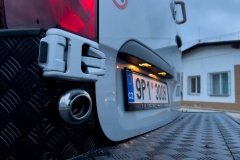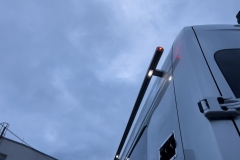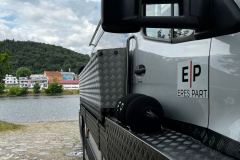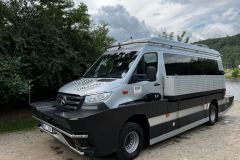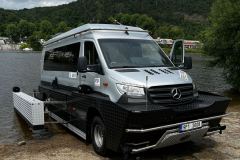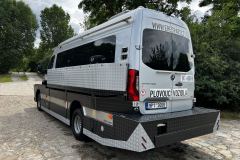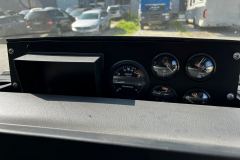We present to you a new, improved amphibious vehicle on the Mercedes-Benz Sprinter chassis. Now on a new platform and carrying the latest proven ship features.
The vehicle is recreated from a real Mercedes-Benz Sprinter 4x4 base with a 140kW engine, automatic transmission and is equipped with all modern safety features such as lane keeping, emergency braking before an obstacle and the like.
The width of the vehicle on the road is 2.38 m. The Mercedes-Benz Sprinter platform is in the longest possible XL version and the total length of the vehicle, including pontoons, is 8.1 m. Approach angles are adapted to the purpose for which the vehicle is designed, i.e. 11° front and rear. Passenger boarding is through the front right door. All doors can also be used during the cruise.
The chassis is widened by 200 mm on each side, and for this, widening pads are used on the rear axle, which we had to develop and test for possible homologation. Then the steering, brakes, exhaust, etc. also passed homologation. All these modifications had to be re-homologated so that they met the latest regulations.
The vehicle is designed for 12 passengers and a driver. Seats with 3-point belts ensure passenger comfort, and the driver also has a microphone for a possible guided tour of the city.
The vehicle is in 4x4 drive and is therefore capable of exiting the water without any problems with the connection of the front drive, which is a matter of pressing one button under the steering wheel.
The vessel is made up of buoyancy bodies, which are made of non-absorbent foam and are therefore only mounted in the chassis. In the event of the need for service operations on the vehicle, all these bodies can be easily removed from the vehicle.
The front of the vessel is all on the structure and will take approximately 2 hours to dismantle. The chassis has a sailing arrangement, where the exhaust, differentials, gearbox, wiring, etc. are adapted for this purpose. It is therefore possible to start the vehicle without problems on the surface of water and leave the Mercedes engine running, which we do not need for sailing, but if an air-conditioned interior or heating is needed we would have to keep this engine running.
It is possible to enter the water with the vehicle without any special preparation. This is in the case of transporting up to 4 people. In the case of a larger number of passengers, it is necessary to extend the side stabilizers. This takes approximately one minute before entering the water. These boat stabilizers are a safe element for possible larger waves and full crew.
The vessel is controlled from the driver's seat quite simply. All the necessary indicators are visible above the dashboard. Such as Honda 150HP marine engine tachometer, trim indicator for Honda engine, trim indicator for Torqeedo 10.0 electric motor, fuel gauge for Honda engine, indicator for turning engines sideways, ie rudders. There is also a behind-the-vehicle view screen on the dashboard. For steering control, there is a joystick on the left driver's door, which electrically controls the turning of the ship's engines to the sides. The fore and aft thrust is controlled by the right hand of the master of the vessel. On the right side, a control panel with these two control levers is created. Starting the Honda engine is at this control lever.
Marine engines are located at the rear of the vessel, which slide out under the vessel after entering the water. Then you can just enjoy this unique experience on the water surface.
You will have the opportunity to try this first unique amphibious vessel in Paris, where it will transport tourists. I believe that the experience will be completely unique for everyone.
